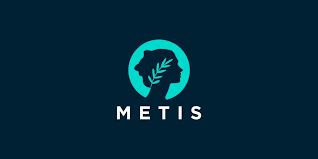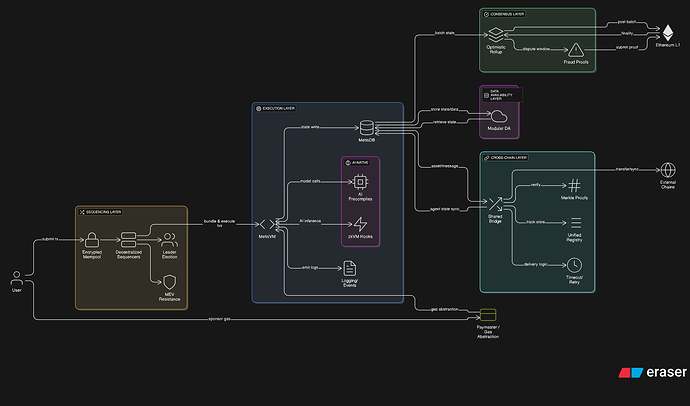GMetis ![]() ,
,
Metis Hyperion isn’t just another Layer 2. It’s a modular, Ethereum-aligned execution layer that combines Optimistic Rollup security, parallel execution, decentralized sequencing, and AI-first architecture.
This post dives into Hyperion’s core technical architecture for builders looking to leverage its bleeding-edge infrastructure for high-performance decentralized applications.
This post is only created for cursory reading. If you have any doubts, always check Official Documentation or ask builders in the forum
System Architecture Overview
Hyperion is designed with modularity and real-time execution at its core. Here’s how it breaks down:
- Execution Layer: Built on
MetisVM, a modified EVM with parallel execution and AI compute compatibility. - Consensus Layer: Uses Optimistic Rollup design secured by Ethereum L1 with fraud proofs.
- Sequencing Layer: Decentralized sequencers handle transaction ordering using MEV-resistance techniques and leader elections.
- Data Availability Layer: Leveraging modular DA (e.g., EigenLayer or Avail), ensuring cost-effective, scalable storage.
- Cross-Chain Layer: The Metis Shared Bridge supports asset and message passing between chains.
Key Features
1. Transaction Lifecycle on Hyperion
Every transaction on Hyperion undergoes a sophisticated but efficient lifecycle:
- User Initiates Tx from wallet or dApp
- Tx enters Decentralized Sequencer Mempool
- Sequencers rotate via leader election
- Tx is bundled and executed by the selected sequencer
- Execution occurs in parallel with other txs via
MetisVM
- Execution occurs in parallel with other txs via
- Result is written to state tree (MetisDB)
- Rollup batch is committed and posted to Ethereum L1
- Fraud proof window begins (dispute period)
- Finality confirmed if no valid fraud proofs are submitted
2. Smart Contract Lifecycle
The smart contract lifecycle on Hyperion mirrors Ethereum, but enhanced for real-time and AI-integrated workflows:
- Contract Deployment
- Developers deploy via standard Solidity or AI-enhanced SDKs
- Validation
- Bytecode and constructor args are validated by MetisVM
- Storage Initialization
- MetisDB uses MVCC (Multi-Version Concurrency Control) to isolate writes
- Execution Phase
- Supports parallel runtime execution using speculative execution engines
- AI-friendly instructions (e.g., model inference calls) supported via zkVM hooks
- Logging & Event Emission
- Compatible with Ethereum-style logs for indexing (e.g., via The Graph)
- Deactivation or Self-Destruct
- Optional; garbage collection handled by the state pruning engine
3. State Transition
The state model follows a variant of the Ethereum state trie but optimized for high-performance rollup systems.
Each block leads to a new state root. Unlike traditional rollups, Hyperion applies multiple state transitions in parallel before computing the final Merkle root.
Key elements:
- Parallel Execution Paths: Executed simultaneously in isolated threads
- Conflict Resolution: Handled via write-ahead logs and deterministic commit logic
- Final State Root: Posted to Ethereum for L1 settlement
4. AI-Native Execution Layer
Hyperion is designed for on-chain AI agents and inference. It supports:
- zkVM Integrations: To verifiably run ML models on/off-chain
- AI-Specific Precompiles: For inference, prediction markets, model staking
- Memory-Aware Execution: Dynamically allocates compute based on context
5. Decentralized Sequencing & MEV Resistance
Unlike centralized rollups, Hyperion uses a rotating sequencer set:
- Leader Rotation Protocol: Prevents single-point ordering
- Encrypted Mempools: Users can encrypt transactions to prevent front-running
- MEV Smoothing Mechanisms: Optionally implement MEV auctions or profit redistribution
This enables trust-minimized ordering and censorship resistance at scale.
6. Cross-Chain Interoperability: The Shared Bridge
Hyperion’s Shared Bridge enables:
- Asset transfer between Ethereum, other L2s, and data availability chains
- Message passing (with zk attestation or optimistic verification)
- AI agent state sync across chains
Bridges use:
- Merkle Proofs for fast verification
- Timeout and Retry logic for message delivery
- Unified Registry to track asset state across networks
7. Native Paymaster & Gas Abstraction
Hyperion includes a Paymaster system at the protocol level:
- Sponsor gas for users (ERC-4337-style or native abstraction)
- Enables gasless UX for onboarding non-crypto natives
- Gas auto-conversion: Users can pay in DAI, USDC, etc.
Great for games, AI agents, and onboarding flows.
Why Build on Hyperion?
For intermediate and advanced developers, Hyperion offers a playground with:
- Web2-like performance
- Ethereum-grade security
- AI-native execution model
- Gas abstraction and seamless UX
- First-class support for agent-based systems and real-time apps
If you’re building the next AI-infused DeFi app, strategy game, or autonomous DAO — Hyperion is where to do it.
![]() Start Building:
Start Building:
Do Let me know if you want to add any link in the comments or over DM ![]()

